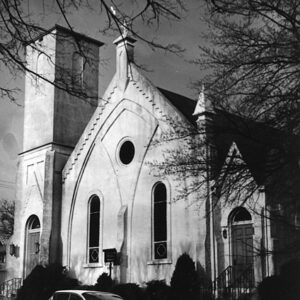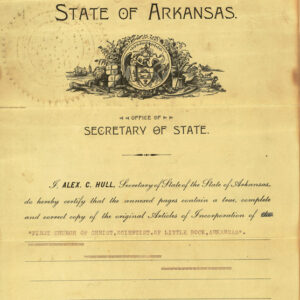calsfoundation@cals.org
Christian Scientists
aka: Christian Science
aka: Church of Christ, Scientist
Despite smaller numbers of followers than other denominations in Arkansas, the Christian Science movement has had a significant impact upon the state. A review of the Arkansas code yields numerous citations and accommodations for Arkansans who find that religious nonmedical healthcare meets their healthcare needs. These citations and accommodations are found in both criminal and civil codes and have been introduced in large part by Christian Scientists.
Mary Baker Eddy, “the only American woman to found a lasting American-based religion,” according to the National Women’s Hall of Fame, founded the First Church of Christ, Scientist in 1879 “to commemorate the word and works of our Master, which should reinstate primitive Christianity and its lost element of healing.” Thirteen years earlier, Eddy had been carried to her home after a severe fall on an icy street. A physician was called; he found her to be in a critical condition having sustained internal injuries. Eddy asked for her Bible and to be left alone. While reading an account of Jesus’s healing, she found herself suddenly well. Eddy devoted the next three years of her life to a deep study of the Bible, searching for the science behind her healing. Eddy’s subsequent years were marked by an impressive record of healings and the teaching of Christian Science to thousands. She published the first edition of her seminal work, Science and Health with Key to the Scriptures, in 1875. The last 100 pages of the book included testimonies of Christian Science healing from individuals across the nation.
In 1879, Eddy and her followers founded the First Church of Christ, Scientist (known as the Mother Church) in Boston, Massachusetts. She opened the Massachusetts Metaphysical College in Boston in 1881 but closed the college in 1889 so that she could devote her attention to a major revision and subsequent edition of the Christian Science textbook. More than 4,000 students were taught by Eddy, including Lou Aldridge, one of the early pioneers who helped establish Christian Science in Eureka Springs (Carroll County). In 1898, Eddy created the Christian Science Publishing Society. Two years before her death in 1910, she founded the international newspaper the Christian Science Monitor. As of 2011, the Monitor has received seven Pulitzer Prizes.
The Christian Science movement entered Arkansas in the 1880s by way of its northwest corridor. Informal groups, societies, and churches were holding Christian Science services in Springdale (Washington and Benton counties), Eureka Springs, and Fort Smith (Sebastian County) by about 1896.
A prayer-based system of healing physical and mental maladies, along with its adherence to the Bible, helped the denomination take root. Many of the early pioneers of the Christian Science movement were Christian Science practitioners, or healers. These individuals, such as Mrs. H. W. Hewitt, Lou Aldridge, and Clara Davis (who helped to establish Christian Science in Springdale, Eureka Springs and Fort Smith, respectively), had a public practice of providing prayer-based treatment as explained in Science and Health with Key to the Scriptures.
Former Arkansas state representative and attorney Herbert M. Beck, known for his work in promoting the building of good roads throughout the state, was instrumental in organizing the First Church of Christ, Scientist in Fort Smith in 1899. Soon after the completion of the church, Beck retired from public service to become a Christian Science practitioner.
By 1941, Christian Science branch churches were found in Arkadelphia (Clark County), Blytheville (Mississippi County), Conway (Faulkner County), El Dorado (Union County), Fayetteville (Washington County), Fort Smith, Helena (Phillips County), Hot Springs (Garland County), Jonesboro (Craighead County), Little Rock (Pulaski County), Mena (Polk County), Monticello (Drew County), Pine Bluff (Jefferson County), Rogers (Benton County), Siloam Springs (Benton County), Texarkana (Miller County), and services were held in Walnut Ridge (Lawrence County). The former edifice of First Church of Christ, Scientist in Little Rock, erected in 1920 at the corner of Louisiana and 20th Streets, was placed on the National Register of Historic Places in 1984. The California Mission–style edifice was built by renowned architect John Parks Almand, who also helped design the historic Little Rock Central High School.
In the twenty-first century, Christian Science branch churches and societies can be found in Batesville (Independence County), Cherokee Village (Sharp County), England (Lonoke County), Eureka Springs, Fayetteville, Heber Springs (Cleburne County), Hot Springs, Little Rock, Mountain Home (Baxter County), North Little Rock (Pulaski County), Sherwood (Pulaski County), Rogers, and Springdale. Each of these branch churches and societies support a Christian Science Reading Room or reading center for the exploration of spirituality, prayer, and healing. Reading Rooms are open to the general public and contain items such as the Bible and Bible reference materials, Christian Science literature, and other study aides and books for adults and children. There are more than 1,700 Christian Science branch churches and societies throughout the world.
For additional information:
The Church of Christ, Scientist. http://www.christianscience.com (accessed January 25, 2022).
Droessler, William. “Dogma vs. Diversity: The Christian Science Movement Comes to Monticello.” Drew County Historical Journal 3 (1988): 44–56.
“First Church of Christ, Scientist.” National Register of Historic Places nomination form. On file at Arkansas Historic Preservation Program, Little Rock, Arkansas. Online at https://www.arkansasheritage.com/arkansas-preservation/properties/national-registry (accessed July 14, 2022).
Hempstead, Fay. Historical Review of Arkansas, Its Commerce, Industry and Modern Affairs. Vol. 2. Chicago, IL: The Lewis Publishing Company, 1911.
Inventory of the Church Archives of Arkansas, First Church of Christ, Scientist, 1941. Work Projects Administration. The Arkansas Historical Records Survey, Division of Community Service Programs. Work Projects Administration. Little Rock, Arkansas, 1941.
The Mary Baker Eddy Library. http://www.marybakereddylibrary.org (accessed January 25, 2022).
Kwadjo Boaitey
Little Rock, Arkansas
 First Church of Christ-Scientist
First Church of Christ-Scientist  Church Articles of Incorporation
Church Articles of Incorporation 




Comments
No comments on this entry yet.